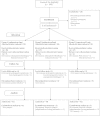A prospective, randomized, double-blind, and multicenter trial of prophylactic effects of ramosetronon postoperative nausea and vomiting (PONV) after craniotomy: comparison with ondansetron
- PMID: 25104916
- PMCID: PMC4124476
- DOI: 10.1186/1471-2253-14-63
A prospective, randomized, double-blind, and multicenter trial of prophylactic effects of ramosetronon postoperative nausea and vomiting (PONV) after craniotomy: comparison with ondansetron
Abstract
Background: Craniotomy patients have a high incidence of postoperative nausea and vomiting (PONV). This prospective, randomized, double-blind, multi-center study was performed to evaluate the efficacy of prophylactic ramosetron in preventing PONV compared with ondansetron after elective craniotomy in adult patients.
Methods: A total of 160 American Society of Anesthesiologists physical status I-II patients aged 19-65 years who were scheduled to undergo elective craniotomy for various intracranial lesions were enrolled in this study. All patients received total intravenous anesthesia (TIVA) with propofol and remifentanil. Patients were randomly allocated into three groups to receive ondansetron (4 mg; group A, n = 55), ondansetron (8 mg; group B, n = 54), or ramosetron (0.3 mg; group C, n = 51) intravenously at the time of dural closure. The incidence of PONV, the need for rescue antiemetics, pain score, patient-controlled analgesia (PCA) consumption, and adverse events were recorded 48 h postoperatively.
Results: Among the initial 160 patients, 127 completed the study and were included in the final analysis. The incidences of PONV were lower (nausea, 14% vs. 59% and 41%, respectively; P < 0.001; vomiting, P = 0.048) and the incidence of complete response was higher (83% vs. 37% and 59%, respectively; P < 0.001) in group C than in groups A and B at 48 h postoperatively. There were no significant differences in the incidence of PONV or need for rescue antiemetics 0-2 h postoperatively, but significant differences were observed in the incidence of PONV and complete response among the three groups 2-48 h postoperatively. No statistically significant intergroup differences were observed in postoperative pain, PCA consumption, or adverse events.
Conclusion: Intravenous administration of ramosetron at 0.3 mg reduced the incidence of PONV and rescue antiemetic requirement in craniotomy patients. Ramosetron at 0.3 mg was more effective than ondansetron at 4 or 8 mg for preventing PONV in adult craniotomy patients.
Trial registration: CLINICAL RESEARCH INFORMATION SERVICE (CRIS) IDENTIFIER: KCT0000320. Registered 9 January 2012.
Keywords: Craniotomy; Ondansetron; Postoperative nausea and vomiting; Ramosetron.
References
-
- Fabling JM, Gan TJ, El-Moalem HE, Warner DS, Borel CO. A randomized, double-blinded comparison of ondansetron, droperidol, and placebo for prevention of postoperative nausea and vomiting after supratentorial craniotomy. Anesth Analg. 2000;91(2):358–361. - PubMed
-
- Fabling JM, Gan TJ, Guy J, Borel CO, El-Moalem HE, Warner DS. Postoperative nausea and vomiting. A retrospective analysis in patients undergoing elective craniotomy. J Neurosurg Anesthesiol. 1997;9(4):308–312. - PubMed
-
- Kathirvel S, Dash HH, Bhatia A, Subramaniam B, Prakash A, Shenoy S. Effect of prophylactic ondansetron on postoperative nausea and vomiting after elective craniotomy. J Neurosurg Anesthesiol. 2001;13(3):207–212. - PubMed
-
- Madenoglu H, Yildiz K, Dogru K, Kurtsoy A, Guler G, Boyaci A. Randomized, double-blinded comparison of tropisetron and placebo for prevention of postoperative nausea and vomiting after supratentorial craniotomy. J Neurosurg Anesthesiol. 2003;15(2):82–86. - PubMed
-
- Pugh SC, Jones NC, Barsoum LZ. A comparison of prophylactic ondansetron and metoclopramide administration in patients undergoing major neurosurgical procedures. Anaesthesia. 1996;51(12):1162–1164. - PubMed
Publication types
MeSH terms
Substances
Associated data
LinkOut - more resources
Full Text Sources
Other Literature Sources


